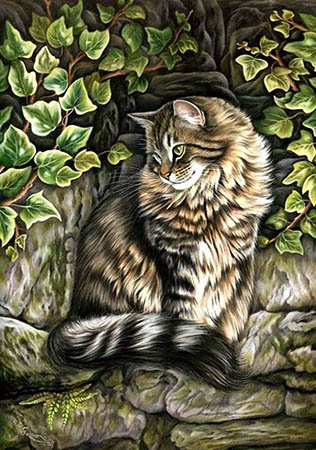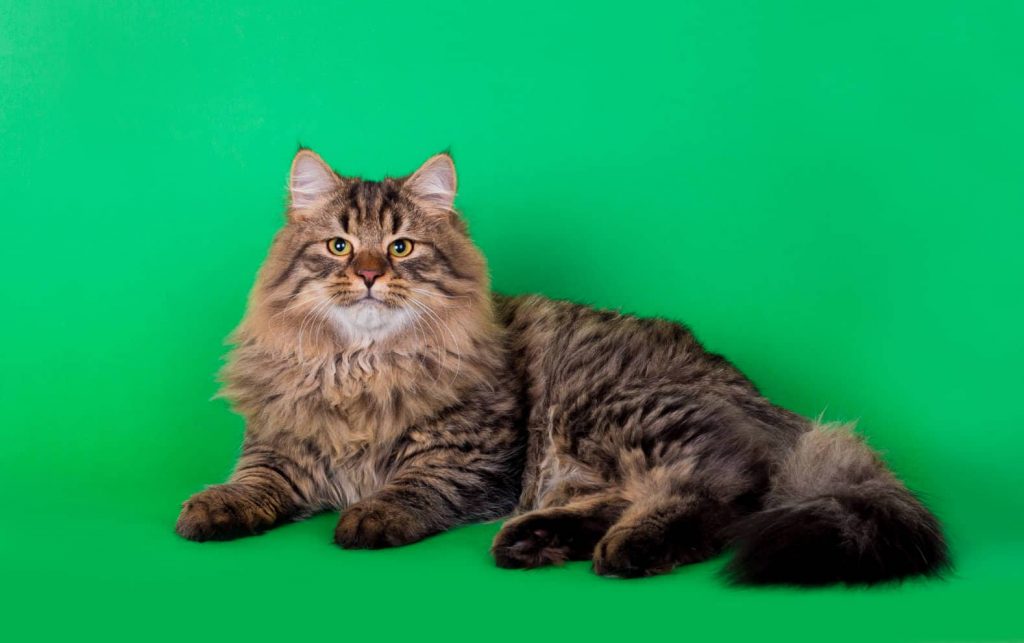Traditional Siberian Cats

To understand Siberian cats, you need to understand the concept of a natural breed.
The definition of a natural breed is a population of native animals that are the product of spontaneous selection in isolated areas, bearing common phenotype. Animals which have developed over a long period of time and as a result have adapted to the local natural environment in which they live.
We can observe several adaptations in Siberians:
The fur between the paw’s cushions to protect the skin from the contact with snow. They have hairy feet!
The fur on their back is made of thick hair with a very dense undercoat and a hard, glossy texture with a water repellent effect that will allow the cat to stay dry in contact with the snow or puddles of melted ice and therefore stay warmer.
Here is how Alexander Kolesnikov (geneticist and Siberian breeder) describes Siberian fur: “There is a certain rule of thumb regarding Siberian fur. It can be fluffy to any possible extent in the collar and downwards to the belly, but at the shoulders and back it should lay rather flat irrespective of the season. Underneath, you can see a lot of dense and relatively thin fur, but the cover decorating fur is harsh and by no means fluffy. Sometimes it forms a kind of very dense and thick “pillow” like in the photo below. Many judges are just unaware of all the above said”.
The medium/long thick tail that will help the cat to stay warm.
The eyes set well apart in an oval shape to allow the cats a better vision in a monochromatic landscape like ice and snow.
Regarding Siberians, the breed is new but the cats themselves are very old and the genetic analyses of of individuals, show they evolved in many areas in Russia and have spread all around this huge country since there were many episodes of rural exodus in Russian history taking men and their animals from the country to metropolitan areas.

I will use as an example Yasha, a magnificent Siberian foundation* cat from the Kranoyarsk area or I could use Kleopatra, a female foundation* found in the Kurgan area or yet Vasily Vasilich from Omsk.
Cats like Yasha, made the joy of Russian kids and families throughout Russia and they also illustrated Russian Folklore and arts in general since the Russian people love their animals..
Several of my Russian friends, from many areas in Russia, owned or saw friendly, big brown cats in their home town and some had the pleasure of owning a Siberian cat.
I was contacted by a Russian lady from Kranoyarsk who wanted to be a breeder and reached me for help. She could not understand where the blue eyed cats she was seeing around in web sites came from or why people were calling them “Siberians”! She had never seen one Siberian with this look where she grew in Kranoyarsk and the Neva look was confusing, it was “new” for her.
In Russia, back then and even now, when you talk about a Siberian cat, most people will think about a big brown cat. The image of a big, friendly brown tabby cat is what the word “Siberian” evokes in Russia.
Siberian stud book is still open, it is still possible to find new foundation* cats but unfortunately the Russian scenery has changed a lot recently.
Nowadays, there are many cats from other breeds being brought in, bred and owned as pets. Most of the time these are not neutered and roaming freely. Therefore, new foundation* cats must be chosen carefully by a specialist since the cats might not be what they used to be in the past. Breeders should be extremely prudent when bringing in a new cat and it is their duty to warn pet buyers if one parent is a new cat close to foundation* and present all the tests that have been done with the cat in question.
Good traditional breeders work with the purpose of keeping the cats as close as they used to be in the past, but preserving the diversity in the gene pool, avoiding influence from other breeds and keeping them healthy.
A traditional cat is not simply a “brown tabby cat”, a traditional cat has a traditional genealogy going back to these beautiful first Siberian cats like Yasha.
You can have a brown tabby cat with a Neva parent and several Nevas in the genealogy but in this case the cat is simply a brown cat born from a Neva mixed line. It is clearly not only a question of fur color but a question of blood and lineage. A brown cat born from a Neva parent is simply a “brown Neva”.
Most traditional breeders are not “Neva” haters, most of us believe there is space for both cats to be equally appreciated by pet owners or by new breeders to be; it is simply a question of taste regarding pet owners and a question of choice, admiration and conviction regarding traditional breeders. Several of us took this direction by falling in love with one real traditional Siberian, in my case Rossity Irvin, the most amazing Siberian cat, extremely intelligent, affectionate and expressive cat in the world. I had never seen in my 48 years of life a cat like Irvin, like Taifun Adagio, Ilmen Sibaris, Amazone Astera, with this superior intelligence and so close and affectionate. They are the perfect companions.
Nowadays it is way easier breeding from mixed lines or breeding Neva, so you can be certain that real traditional breeders are passionate people moved by their love of the breed.
Foundation*: a Foundation is the first cat of a bloodline. Foundation cats must be found and registered in Russia.